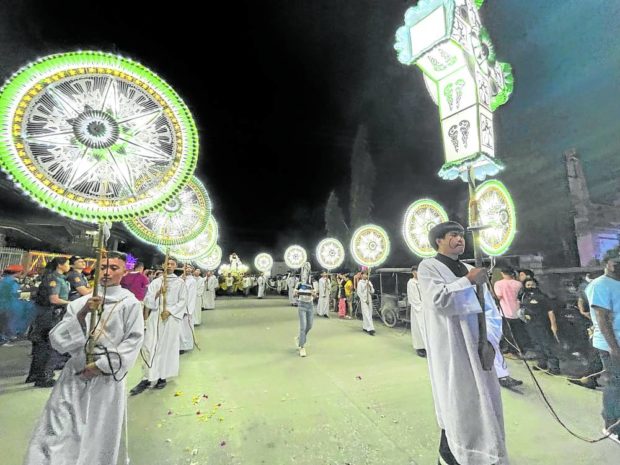
LIGHTING THE WAY | The tradition of “lubena,” or the holding of nightly processions of handheld lanterns for the nine-day Christmas Masses, resumes in 25 of 27 villages in Magalang, Pampanga. Made by the skillful hands of community members, the lanterns light the path of patron saints and attract the faithful to attend the Mass. (Photo by TONETTE OREJAS / Philippine Daily Inquirer)
MAGALANG, Pampanga, Philippines — Almost three years into the COVID-19 pandemic, 25 of 27 villages in this Pampanga town at the foothills of Mt. Arayat mounted again their “lubena,” signaling the resumption of the old Catholic tradition beginning on Thursday.
The lubena is a nightly procession of hand-carried lanterns held during the nine-day Masses leading up to Christmas Day.
Danilo Cortez, 60, said the big white paper lantern was “not even a bit burdensome” when he carried it with his bare hands around the San Bartolome Parish on Tuesday night.
Eleven other men, including 13-year-old JM Sarmiento, held lanterns that illuminated the path of the village’s patron saint, San Antonio, who was borne on an “andas” or “carozza” (shoulders or carriage). A diesel-powered generator lighted the lanterns that glowed more with the accompaniment of candle-lit lamps made of metal or cardboard held by villagers.
Here, the lubena is called the “Banal a Batuin ning Magalang” (Holy Star of Magalang).Older folks used the term lubena for novena or any nine-day religious practices or prayers, according to Mayor Maria Lourdes Paras-Lacson, in whose term the surviving tradition gained the Philippine Heritage Award in 2018 as an intangible cultural heritage.
Six parishes
Magalang and the cities of Angeles and Mabalacat in northern Pampanga still hold the lubena. Magalang’s version is seen to be more intricate and adopted as a program of the local government since 2016.
The mobile tableau symbolized Jesus Christ through a large crucifix-shaped lantern. The 12 lanterns arranged in two rows represented the apostles. One village carried a fish-shaped lantern to signify St. Peter, the so-called “fisher of men” who became the first Pope murdered for the faith.
Lantern bearers danced slowly in sync in sideway-forward-backward steps. Some women volunteered to carry the lanterns.
The congregation recited the rosary, singing also the “goso” (hymn for saints and souls), “Dios Te Salve” and “Virgin Divino.”
In other villages, the lubena is joined by parish priests, altar assistants who toll handheld bells, a maiden representing Queen Helen who found the Cross, and a complete musical band.
This time, villages clustered in six parishes performed the lubena.
Municipal treasurer Raissa Bayani, chair of the Lubena ning Pasku committee, said each village received training to refresh the craft and skills in lantern-making, getting also a P20,000 subsidy.
Judges chose the lubena of Barangay San Jose to be the most beautiful, earning it P100,000 in cash prize and P1 million worth of local government-funded project.
On Christmas Eve, the lubena in the villages were expected to converge at the grounds of San Bartolome Church where the faithful attend the Christmas Eve Mass. The images of saints and lanterns remain outside in what old folk call “maytinis.”
Fr. Ronnie Cao, who served in Magalang until 2019, said the lubena “gave a deeper meaning in the preparation, as well as in the celebration, of Christmas as we worked together as one community.”
Origins
When exactly the lubena began is unknown. Historical data papers of Magalang that are in the care of the Holy Angel University’s Center for Kapampangan Studies and compiled in 1952 by a local committee headed by Loreto Pinto include accounts of lubena in Sto. Rosario and San Antonio.
Sto. Rosario village has an “official lantern maker”—Bernardino Pingol. The Sto. Rosario accounts also referred to a lantern competition in the town, complete with cash prizes.
The lubena tradition in Magalang is believed to have come from Bacolor, a former capital of Pampanga. Several Magalang pioneers like Isidoro Licup Ayuyao originated from Bacolor while a number of Augustinian priests and native clergy served in Bacolor prior to their postings in Magalang.
Local historians believe the lubena of Bacolor inspired the making of giant lanterns in the City of San Fernando since 1908. In the awarding rites, Lacson noted that the lubena were like stars that brightened the dark sky, giving people the “symbol of hope for a better tomorrow.”